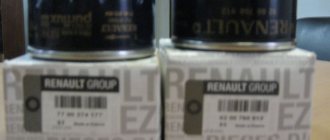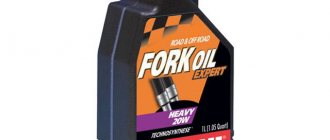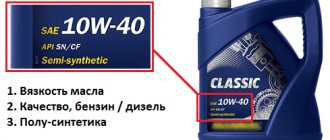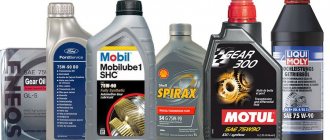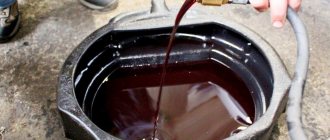What does the marking hide?
Average ranges of oil performance
In order to understand the differences in the consumer properties of oils, it is necessary to understand what the letter and numerical markings hide. According to the international SAE classification, all motor oils can be of three types: summer, winter and all-season. The fact that the oil is a summer type is indicated by the marking consisting of two-digit numbers - 20,30,40. They indicate a high-temperature limit, until reaching which the technical fluid will maintain stable performance. The winter classifier includes one number and the letter w - 5w, 10w, 15w. The letter is a symbol indicating the suitability of the liquid for low-temperature conditions (from the English word winter), while the number conventionally indicates the cold temperature range. The versatility of the lubricant is evidenced by the presence of two indicators - summer and winter.
The types of oils under consideration - 5w40 and 10w40 - refer to all-season motor oils.
Their second indicator is the same - 40. That is. both oils have the same high temperature threshold. And it is 40 degrees Celsius. This indicator characterizes only the ambient temperature: the heated surface of the engine is much higher. The difference in liquids in the first numerical designations indicates their different susceptibility to cold weather conditions: 5w can withstand up to -30 degrees Celsius, 10w - up to -25. If the specified frost limit is exceeded, the viscosity of the lubricant increases, as a result of which effective circulation of fluid inside the engine compartment becomes impossible.
Is it possible to use 5w40 oil in summer?
Returning to the beginning of the conversation, we will try to answer the second burning question of the day - is it possible to pour 5w40 oil in the summer?
Popular opinion is divided, but the majority believes that it is not possible, but even necessary, since 5w40 is thicker, therefore it is guaranteed to form a protective film on all elements of the unit rubbing against each other. The opinion is partly correct, but only partly.
Expert opinion
It is definitely possible if this oil is indicated for use specifically for specific engines and specific machines. If you look at the service book, you will see not just one specified motor lubricant, but a list with parameters at which the car’s engine will feel especially comfortable and not wheeze under extreme loads. You need to pay attention to viscosity, since all synthetic oils are more “liquid” in relation to semi-synthetics, which means that in the heat they will turn into “water” if the thickener additive does not correspond specifically to your engine modification. The result is that the engine parts work dry, then we stand and repair them.
Continuing according to the service book, which also indicates the service life with critical marks. This is done so that the car enthusiast pays attention to the engine, takes it for preventive maintenance and determines its condition. Many engine models require changing the oil after mileage to a thicker one, although pure synthetics were initially intended; the manufacturer also indicates this, if not in the book, then in the manual. Just go to the official website and read.
Arguing further about whether it is possible to use 5w40 oil in the summer, I would like to note that most lubricating fluids of this class are synthetic, therefore, using a more viscous one for the summer does not violate the main recommended series, provided that synthetics are indicated. Again, you need to look at what additives the manufacturer has provided in each specific case, and whether they are suitable for engine feeders, since the side effects of oils can be different.
Eg. Oils with strong engine cleaning additives are simply contraindicated in most cases for engines with a mileage of more than 150,000; it is better to use extreme pressure additives, otherwise you can specifically clean the engine, especially if the latter has never undergone a major overhaul or high-quality preventive maintenance.
Similarities and differences
Motor oils 10W-40 and 5W-40
When choosing 5w40 or 10w 40, it is important to understand the difference between them. As mentioned above, 5w40 and 10w40 belong to the universal class, i.e. they can be used all year round. They ensure easy starting of a cold engine, instantly pump the lubricant throughout the engine working area and provide it with reliable protection against overheating over the long life of the vehicle. Their difference in the first digits of the marking would seem to affect only the low-temperature limit. However, the difference suggests that a liquid with an index of 5w is more fluid than its counterpart 10w. Thus, despite the same high-temperature range, 5w40 protects the engine in hot conditions somewhat worse. Not without this, the liquid material at extremely elevated temperatures acquires even greater fluidity, which leads to the composition being washed off from the working surfaces of engines and to a decrease in the wear resistance of parts. If you live in very hot areas, it is recommended to fill the “ten” in the summer.
Comparison of laboratory analyzes of 5W-40 and 10W-40
To roughly compare the difference in these viscosities, let’s take the products of the domestic manufacturer Lukoil Lux. In this case, 5ka is synthetic, and 10ka is semi-synthetic, which can give some difference when conducting laboratory tests. However, synthetics are more stable.
| Characteristic | 5W-40 | 10W-40 |
| Kinematic viscosity at 40℃ | 79,21 | 93,60 |
| Kinematic viscosity at 100℃ | 13,73 | 14,22 |
| Pour point | -44℃ | -38℃ |
| Flash point | 235℃ | 222℃ |
| dynamic viscosity CCS | 5490 (at -30℃) | 4730 (at -25℃) |
Although the high-temperature index for oils is the same, in this case the 5k has a higher flash point, for the reason that I stated above - it is synthetic. Which once again confirms: you should not rely only on the SAE value; everything depends on both the composition of the oil and the technology of its production. When selecting, we take the required SAE and compare the brands with each other according to their indicators, choosing the optimal one.
In viscosity, as I said, the run-up is small. 10ka is thicker, but not significantly. If we compare, for example, with 5W-30, then this 5ka will be almost twice as thin. So the viscosities under consideration are quite interchangeable. BUT. We always follow the recommendations of the engine manufacturer.
As for pumpability in cold weather, the difference will also not be very big. The pour point differs slightly, but the dynamic viscosity indicator is much more important in this matter. In this case, it is impossible to simply compare numbers with each other, since each viscosity has its own upper limit and temperature. For clarity, here is another sign:
| SAE Viscosity | Upper limit of dynamic viscosity CCS | Test temperature | Actual indicator of Lukoil Lux oils |
| 5W | 6600 mPa*s | -30°C | 5490 mPa*s |
| 10W | 7000 mPa*s | -25°C | 4730 mPa*s |
The lower the oil falls from the specified limit in its performance, the easier it is to pump in cold weather. That is, in fact, both of these oils can be started safely at -30, if you draw the boundary of the distance of each viscosity from the limit.
Of course, not all brands will have the same small differences between viscosities, but in general the picture will be similar.
5w40 or 5w30: what to choose?
We've figured out what the difference between 5w and 10w is, now let's try to understand whether the difference between oils is significant when the differences lie in the second labeling indicator.
From the point of view of winter operation, both oils retain stable properties down to -30 degrees Celsius. They provide easy starting of a cold engine, efficient circulation of the working mixture and optimal protection of mechanisms from wear. Manufacturers of motor oils also note that in lower temperature conditions the operation of liquids is relevant, but it requires a more powerful source of energy capable of cranking the crankshaft when the oil is too viscous.
The climatic limit for the “five” is -45…-55 degrees. In this range, the working fluid completely solidifies.
In winter, it doesn’t matter what is poured under the hood: 5w30 or 5w40 oil. In critical conditions they will behave the same way.
Although both lubricants are classified as all-season lubricants, in hotter areas it is recommended to use a thicker oil during the summer. The viscous base has high temperature resistance and does not allow the film to simply run off from the structural elements of the power unit.
There is no difference in using oil with temperatures of 30 and 40 to thirty degrees Celsius. Both fuels and lubricants operate within the parameters stated by the manufacturer. If the specified limit is exceeded, the oil with a lower indicator will enter a phase of sufficient viscosity to drain from the engine components. “Defenseless” parts will aggressively interact with each other, forming severe overheating inside the motor. This effect is dangerous for the car due to jamming of the crankshaft, wear of the motor mechanisms and excessive consumption of the fuel mixture.
Briefly about labeling
When choosing a lubricant suitable for an engine, the question often arises of which product to choose so as not to harm the engine. The main characteristics when choosing a suitable composition is the approval for the use of the substance.
The second point that you should also pay attention to is the thickness of the product. The thicker the lubricant, the better it will withstand heat, and vice versa. Oils 5w40 and 10w40 are all-season. Both compositions are very popular among motorists in central Russia and the southern regions. The marking indicates that the substance can be used at very low temperatures.
If you rely on the designation, then 5w40 is more universal than 10w40. The product can withstand low temperatures and ensures that the engine starts even when cold. In turn, 10w40 is a semi-synthetic, differing in the method of production. This type of grease should be used at higher temperatures. When the thermometer drops below -25 degrees, the engine may not start. As a result, we can say that lubricants differ in temperature of use.
How to choose oil for your car?
The first thing you should be guided by when choosing a fuel and lubricant composition is the recommendations of the car manufacturer. Compliance with the required degree of viscosity will extend the life of the motor unit and provide it with the necessary level of protection. However, it is worth considering some features.
Scheme for studying motor oil labels
Firstly, the climatic conditions of your region. If interseasonal temperature changes are too large, then the motor fluid must remain operational in the same range. Secondly, take into account the mileage of the car. If the automaker specified the use of 5w40 oil, but the vehicle has already traveled more than one hundred thousand kilometers, you can replace the fluid with a more viscous one - 10w40. This can only be done if the service book does not contradict this. The fact is that no technical fluid can completely neutralize the force of friction.
After the first hundred thousand kilometers, the gaps between the structural elements of the engine increase, and the former lubricating film is no longer sufficient to ensure maximum efficient operation of the vehicle.
If the oil used is thicker, the film formed on the mechanisms will gain the necessary strength and thickness. In other words, a thicker lubricant composition will restore the original properties of the motor and increase its service life.
Common features
Both categories of liquids can be used for highly accelerated engines with an installed turbocharger and direct fuel injection system. The formulas are compatible with moderate climatic conditions and can be poured anywhere in the CIS countries.
Note! The car manufacturer indicates the recommended fluid parameters in the car's service book. It is strictly forbidden to deviate from the manufacturer's requirements.
Oil compatibility
Have you ever noticed rapid oil consumption in your car? This problem occurs when there is a malfunction in the vehicle’s propulsion system or when choosing a low-quality oil lubricant. In any of the above cases, topping up is necessary. But what if you have a thinner liquid on hand? Or is its chemical composition different from the lubricant poured under the hood? What happens if you mix mineral water with synthetics and is it possible to mix oils with different markings, say, 5w40 and 10w40?
Stages of motor oil production
If you want to drive your car for hundreds of kilometers, then do not experiment with various technical fluids. Even if their manufacturer is the same, a homogeneous mixture will not result due to differences in the chemical composition. As a result, the performance properties of the engine oil will be unpredictable, and the replacement interval will be reduced to a minimum.
In emergency cases, when, say, a problem with an oil base leak occurs on the highway, you can add an excellent composition of fuel and lubricant, but only to get to the nearest service center.
You cannot run heterogeneous engine oil under the hood for a long time. By the way, after mixing motor lubricants, it is recommended to flush the engine. Unwashed particles of a previous low-quality mixture can significantly spoil the consumer properties of fresh oil.
Is it possible to mix 5W-40 and 10W-40
You can mix, but in rare cases, using the same brand of oil and not overusing such mixing. It should be understood that the viscosity of the oil will fall or rise, depending on the amount of oil added. That is, if you mix the indicated viscosities 50 to 50, the result will be an average value of 7W-40. We also take into account the composition of the oil - synthetic, semi-synthetic or mineral water. I have already discussed mixing oils in more detail earlier in the article on how to properly mix oils from different manufacturers.
Results
It’s good when the car’s engine system works properly and efficiently, but for this it is necessary to answer the question: “What is the difference between 5w40 oil and 10w 40?” and “which oil is thicker 5w40 or 10w 40.” Each brand of vehicle has its own motor fluid capable of restoring and maintaining high performance properties. And it can only be determined with the help of the car manufacturer. Having figured out the difference between 10w40 and 5w40, do not rush to pour them under the hood of the vehicle, but first read the requirements of its operating manual. If it states that the use of a specific viscosity is prohibited, do not neglect this rule. Perhaps it will save you from expensive car repairs.
What is the difference
As can be seen from the SAE markings, 10W-30 and 10W-40 oils differ in their viscosity at maximum temperatures.
If the viscosity is too low, the pressure in the lubrication system will be insufficient, which can lead to oil starvation of the engine. This will lead to excessive wear of the friction pairs, which does not have the best effect on the service life of the motor.
For engines that have spent half their service life, oil with a higher viscosity is required.
This is especially important in the summer, when the engine heats up to its highest levels and the role of oil is especially important. This is not only cooling of rubbing parts, but also reducing gaps to eliminate increased wear of structural elements of the engine
So it turns out that a difference of only five degrees in the temperature at which the oil remains viscous can be important for the “health” of the engine
Synthetic motor oils
Pros: wide temperature range for use, practically does not evaporate, has good cleaning characteristics. As a result of using “synthetics”, less carbon deposits are formed, which allows you to change the engine oil less often. Excellently retains its original properties.
Cons: Used engines or engines that previously used mineral motor oils may experience leaks. This is due to the fact that chemical detergents break down the oil film on gaskets and seals and penetrate into the cracks formed over time.
Production: Synthetic oils are made from ethylene. As you know, ethylene is a natural gas. But they are also made from crude oil using organic synthesis. During this method of manufacturing motor oil, it is easier to control chemical processes, and this, in turn, makes it possible to more accurately “adjust” the oil to the specified characteristics.
Semi-synthetic motor oils
It’s easy to guess that semi-synthetic motor oil is something between mineral and synthetic.
Pros:
Semi-synthetic motor oils have better properties than mineral ones, but the cost is lower than that of synthetic oils.
Production: semi-synthetic oil is produced quite simply; synthetic additives are added to the mineral oil, thereby improving the properties of the mineral oil.


